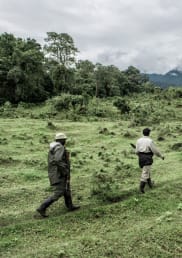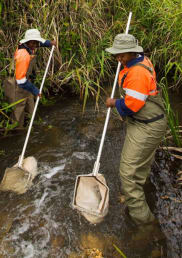Turning up the heat: Climate change, fragility and conflict
This article was written for The Fund for Peace’s 2021 Fragile States Index, a data-driven policy tool covering political, social and economic pressures in 179 countries.

The conflict and fragility landscape is getting increasingly complex as the influence of non-state actors, technology and renewed geopolitical competition has accelerated according to the 2021 Fragile States Index. In 2020 the devastating impacts of COVID-19 added further fuel to the fire, while climate change has not gone away. 2020 was one of the three warmest years on record with floods, bushfires and rapidly melting glaciers and ice caps making the climate change crisis impossible to ignore. It is however the poorest communities in contexts with high levels of fragility that are paying the heaviest price. But why is this the case and how can we start unpacking and addressing the drivers of this?
Fragility is increasingly linked to climate change impacts and unprecedented environmental degradation. It is considered one of the biggest obstacles to reaching the Sustainable Development Goals. Although the causal link between climate change and conflict is not straightforward and is highly context specific, there are a number of identifiable common pathways.
Firstly, loss of livelihoods due to environmental degradation and extreme weather, and the crippling effect on people’s food security can increase social tensions. Secondly, climate change can contribute to increased population mobility whereby the influx of people can place an additional burden on local economies which increases the risk of local resource conflicts. At the same time these contexts with large in-migration lack shared institutions for conflict resolution. Thirdly, the disruption and desperation caused by increased competition over resources and extreme weather events can be exploited by elite, criminal or violent extremist groups for political and economic purposes, particularly where governments are unwilling or unable to effectively respond.
Inequality of access to, and control over, resources such as land, water or forests, coupled with unsustainable resource exploitation, has been a contributing factor in the occurrence of violence in various countries. In Syria, a five-year drought from 2006-2011 together with prolonged unsustainable use of water to irrigate agricultural land forced up to 1.5 million farming families to move to urban areas which is widely believed to have contributed to the conflict that has devastated the country. In several cities in neighbouring Iraq, people have taken to the streets to voice their anger over the poor access to clean water during the last four years. Instead of listening and seeking a solution to the water crisis, the authorities responded with excessive force and the arbitrary arrests of protesters. The situation in Iraq and Syria illustrates how state fragility hampers government’s ability to manage natural resources in a sustainable and equitable way. In fact, we see a vicious cycle emerging whereby poor governance takes attention and resources away from adequately responding to climate challenges which in turn leaves communities more vulnerable, exacerbating existing fragilities, with the potential to translate into violent conflict.



Another region that has been severely affected by climate and fragility risks is the wider Sahel. As early as 2008, the Sahel was dubbed “ground zero” for climate change by the UN Secretary-General’s Special Advisor at the time, Jan Egeland. Today’s sad reality is one of increasingly scarce natural resources, threatening the livelihoods of the rapidly growing population. Climate change projections indicate the situation is only going to get worse with the increase in temperatures in the Sahel predicted to be 1.5 times higher than the global average. In Nigeria, environmental stress and economic and political tensions are fuelling conflict over land, water and cattle between herders and farmers in the Middle Belt. A conflict that killed six times more people than the Boko Haram insurgency in the first half of 2018.
Neighbouring Mali is seeing widespread conflict and insecurity in northern and central parts of the country. The underlying causes of the crisis are long-standing and complex but the climate which is increasingly oscillating between droughts and floods means that nomadic herders and farmers are perpetually competing over shrinking resources, a situation that is being exploited by criminal and violent extremist groups, compounded by elites pursuing their individual political and economic agendas. The situation across the Sahel seems to be moving from bad to worse. The poor governance of its natural resource base has undermined the ability of communities to adapt to climate change impacts resulting in the destruction of millions worth of infrastructure, loss of livelihoods and displacement. For example, the famer herder conflict in Nigeria’s Middle Belt alone, is estimated to have displaced at least 300,000 people.
The ability and resources to adapt to and overcome the adverse effects of climate and fragility impacts varies between groups and individuals, by gender, ethnicity, poverty, unequal social and political power and other processes of exclusion and marginalisation. This heightened vulnerability can rarely be attributed to a single cause and is the result of intersecting social processes and political economies. Although understanding how vulnerability differs is important, recognising and identifying the local agency of those communities at the ‘front line’ of climate change and fragility is also key. While international and national authorities are grappling with the challenge of how to address climate and fragility challenges, we need to ensure communities are being heard and listened to and proposed policies and adaptation approaches are building on their experiences.
There are no easy answers as to how climate and fragility risks can be overcome. Neither is there a quick fix for deficits in resource governance and political inclusion. Nevertheless, the issue requires urgent action. National governments and the international community must accept and embrace the complexity of climate change impacts, fragility, how the two are interlinked and the multidimensional responses required to address them. We can no longer accept this to slide further down the political agenda due to competing priorities and limited resources. It is essential that conflict and peacebuilding become an integrated part of the overall climate crisis response and vice versa, with the necessary resources to stop the situation spiralling further out of control.
Fragile States Index
This article was written for The Fund for Peace’s 2021 Fragile States Index (FSI). You can read the full report and explore the Fragile States Index data by clicking on the following links:






